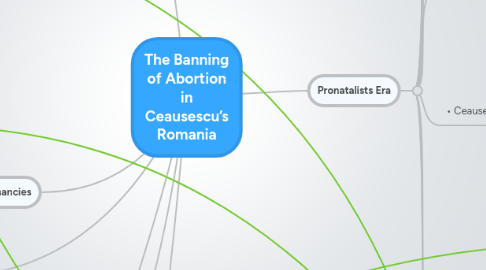
1. Day after Ceausescu is executed abortion is legalized
1.1. Abortion remains primary method of contraception
1.2. Other forms of contraception not available
1.3. In 1990, hospitals reported 70 to 100 abortions a day
1.4. Ration of abortions to live births 3 to 1
1.5. Decreased rate of maternal mortality
1.6. Birthrate declined
2. • “Motherhood – regardless of marital status – was the message” • Women’s magazine Femeia begins to limit articles about household concerns and focus on women in the work place. • Mothers married or single should be respected • “motherhood is itself the meaning of women’s lives” • Articles in state paper Scinteia instructed citizens of “patriotic virtues of large families” and the “noble mission of mothers” • Urban women able to obtain black market contraceptives or illegal abortions from medical personal Rural women less inclined for abortions because of religion and local habits
3. Women's Work
3.1. Cultural or educational institutions
3.2. Agricultural labor more appealing because of flexible schedule
3.3. Working in state sphere
3.4. Doing housework
3.4.1. • No time saving household devices
3.5. Raising children
4. Government Controls Women's Reproductions Rights
4.1. Regime attempts to have women sign contract to produce four children
4.1.1. Women question the implications of the contract
4.1.1.1. What if the child dies?
4.1.1.2. Would they be sent to prison?
4.1.1.3. Would they be required to have another child?
4.2. December 26, 1985 antiabortion law passed
4.2.1. Age of legal abortions raised to 45
4.2.2. Children birthed and reared raised to 5
4.2.3. Childless persons required to pay increased tax
4.3. 1986- new campaign to exam women 16-45
4.3.1. State control of women’s reproductive lives
4.3.2. Annual and trimesterly gynecological exams to verify reproductive health
4.3.3. If pregnancy was discovered women were monitored closely, sometimes hospitalized to prevent abortion
4.3.4. Medical staff followed up with home visits
4.3.5. Women not always aware of pregnancy checks
5. Unwanted Pregnancies
5.1. If women did not want child, some doctors would assist
5.2. Provided claims that women had various ailments including: measles, hepatitis, syphilis, and diabetes to qualify for legal abortion.
5.3. Illegal abortions
5.4. Physicals punished for performing illegal abortions
5.5. Maternal death and deformities increased
5.6. 1965-1989, 9,452 women died because of complications
5.7. Adoption
5.7.1. Romania become adoption hot spot in early 1990s
5.7.1.1. Private market in adoption and “baby trading”
5.7.1.2. Children were being acquired through private connections rather than orphanages
5.7.1.3. Humanitarian opportunity for children to have a better life
5.7.1.4. Adoption of Gypsy children viewed by many Romanians as a legitimate way to rid the country of Gypsies
5.7.2. Private adoption
5.7.2.1. Faster than bureaucratic procedures
5.7.2.2. More expensive
5.7.2.3. Led to corruption and coercion
5.7.2.3.1. State trade in babies for money
5.7.3. July 16, 1991, new law requiring adoption to be done through institutional process
5.7.3.1. Legitimate adoptions
5.7.3.2. Mother had 15 days to change mind about adoption
5.7.3.3. Change in decision was not always accepted
5.7.3.4. Children must be orphans for at least 6 months
5.7.3.5. Natal parents given the opportunity to reunite with abandoned children
5.7.3.6. Seek Romanian citizens for adoption first
5.7.3.7. Foreign adopters as a final option
6. Post-Ceausescu Era
6.1. Rights to abortion provide women with control of their bodies and lives
6.1.1. Abortions performed in factory like setting
6.1.2. Hospital raises price of abortions from 30 to 500 lei
7. Pronatalists Era
7.1. “Normal demographic growth”
7.2. “triumph of socialism”
7.3. Equal pay for equal work
7.4. Reproduction considered needed contribution from families for socialist agenda
7.5. Law 770/1966 introduced
7.5.1. Prohibited abortions
7.5.2. Exceptions:
7.5.2.1. • Had already delivered and reared 4 children
7.5.3. Endangered mother’s life
7.5.4. Hereditary disease
7.5.5. Result of rape
7.5.6. Aged 45 or older
7.6. "Heroes of socialist labor”
7.7. “Heroine Mother”- 10 or more children
7.8. “Order of Maternal Glory” 7-9 children
7.9. “Medal of Maternity”- 5-6
7.10. Children acquired through adoption or second marriage do not qualify
7.11. Minimum age for abortion 40
7.12. • Ceausescu’s views:
7.12.1. Opposed gender discrimination
7.12.2. Emphasized role of women in politics, economy and society
7.12.3. Stresses of working mothers
7.12.4. Talked about but never fulfilled :
7.12.5. Childcare facilities
7.12.6. Distribution of household appliances
7.12.7. Semi-prepared foods
7.13. 1984: Ceausescu wants women to bear 4 children or more
7.13.1. • 1980 childbearing became obligatory
7.13.1.1. • Progressive measures to encourage pregnancy
7.13.1.1.1. Financial allowances
7.13.1.1.2. Child support benefits
7.13.1.1.3. Maternity leave
7.13.2. Families unable to feed current children expected to have more
7.13.2.1. Unwanted children abandoned and neglected
7.13.2.1.1. Institutionalization of innocent children
7.13.2.1.2. International trafficking of babies and children
7.13.2.1.3. AIDS infected transfusions given to children in orphanages
7.14. Goal to increase population from 22.6 to 25 million by 1990
7.15. Birthrate declined to 14.3 per 1,000 in 1966
7.15.1. 1983 birthrate declines to 1966 level
